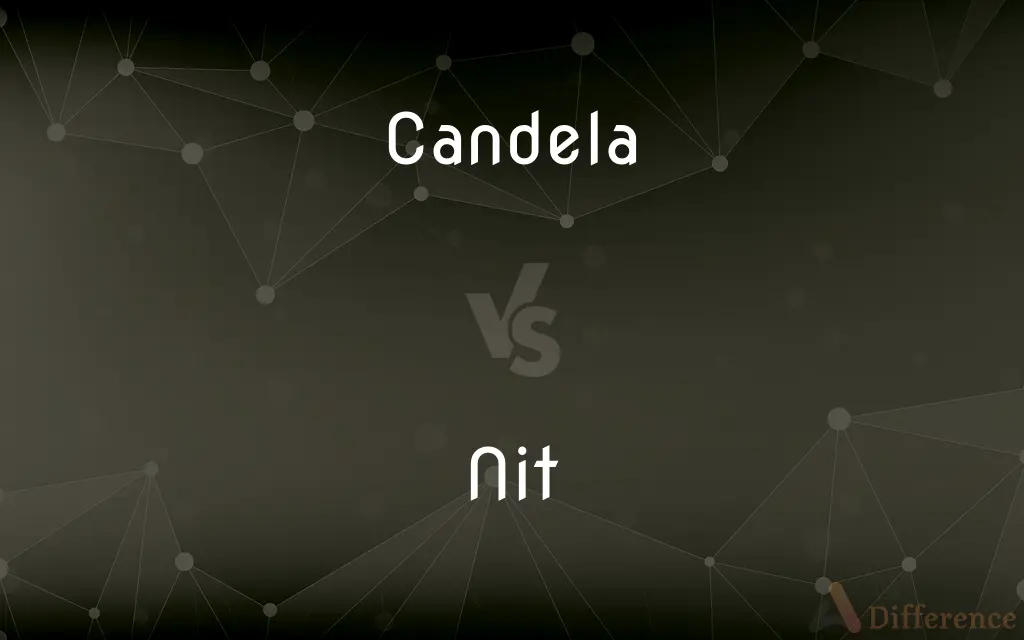Candela vs. Nit — What's the Difference?
By Fiza Rafique & Maham Liaqat — Updated on April 16, 2024
Candela measures luminous intensity in a specific direction, focusing on light's visual impact, whereas a nit measures luminance, quantifying brightness perceived by the human eye over an area.

Difference Between Candela and Nit
Table of Contents
ADVERTISEMENT
Key Differences
Candela is a unit of luminous intensity under the International System of Units (SI), gauging how much light is emitted from a light source in a particular direction. In contrast, a nit is used to express luminance, reflecting how much light a surface emits or reflects.
The candela specifically measures the power of light as perceived by the human eye, based on a standardized model of human vision. On the other hand, nits provide a measurement of brightness over an area, which is critical in evaluating display screens and lighting conditions.
One candela represents the luminous intensity, in a given direction, of a source emitting monochromatic radiation at 540 terahertz and that has a radiant intensity of 1/683 watts per steradian. Whereas, one nit equals one candela per square meter, thus making it a measure of brightness per unit area.
In practical applications, the candela is essential for designing lighting systems where directional light intensity is crucial, such as in headlights or spotlights. Conversely, nits are particularly important in the context of display technologies, where understanding how bright a screen appears in various lighting conditions is key.
While both units are essential in their domains, candelas are more about the "strength" of a light in a specific direction, whereas nits address how "bright" a surface is due to the light emitted or reflected from it.
ADVERTISEMENT
Comparison Chart
Definition
Unit of luminous intensity
Unit of luminance
System
International System of Units (SI)
Derived SI unit
Measurement Focus
Intensity of light in a specific direction
Brightness of a surface
Typical Use
Light source intensity in devices like headlights and projectors
Brightness of screens and displays
Relation to Vision
Measures light based on human visual perception at 540 THz
Measures brightness perceived by humans
Compare with Definitions
Candela
Measurement based on the human eye's sensitivity.
Adjusting the candela output of a lamp can enhance visibility without increasing energy consumption.
Nit
Used in various display technologies.
OLED screens often boast higher nits for better visual impact.
Candela
Essential for directional lighting applications.
Automotive headlights are designed to have a specific candela value for safety.
Nit
Indicates how bright a display appears to the observer.
For outdoor use, screens need to be at least 500 nits to ensure readability in sunlight.
Candela
Unit of luminous intensity in a specified direction.
A 60-watt bulb has a luminous intensity of about 64 candelas.
Nit
Unit measuring the luminance of a surface.
The latest smartphone displays can reach up to 1000 nits of brightness.
Candela
Used to characterize the strength of light emissions.
The laser's intensity was measured at 300 candelas.
Nit
Derived from the candela per square meter.
Adjusting the backlight increases the nits value of the TV.
Candela
Standardized under the International System of Units.
All lighting equipment must specify its output in candelas to comply with international standards.
Nit
Relevant in assessing display quality.
Higher nits are preferred for HDR content to enhance the viewing experience.
Candela
The candela ( or ; symbol: cd) is the base unit of luminous intensity in the International System of Units (SI); that is, luminous power per unit solid angle emitted by a point light source in a particular direction. Luminous intensity is analogous to radiant intensity, but instead of simply adding up the contributions of every wavelength of light in the source's spectrum, the contribution of each wavelength is weighted by the standard luminosity function (a model of the sensitivity of the human eye to different wavelengths).
Nit
The egg or young form of a louse or other parasitic insect, especially the egg of a human head louse attached to a hair.
Candela
The SI unit of luminous intensity equal to 1/60 of the luminous intensity per square centimeter of a blackbody radiating at the temperature of solidification of platinum (2,046 K). See Table at measurement.
Nit
A foolish person
You stupid nit!
Candela
In the International System of Units, the base unit of luminous intensity; the luminous intensity, in a given direction, of a source that emits monochromatic radiation of frequency 540 × 1012 hertz and that has a radiant intensity in that direction of 1/683 watt per steradian. Symbol: cd
Nit
Used as a warning that someone is approaching.
Candela
The basic unit of luminous intensity adopted under the System International d'Unites.
Nit
The egg of certain parasitic insects, especially a head louse.
Candela
The basic unit of luminous intensity adopted under the Systeme International d'Unites; equal to 1/60 of the luminous intensity per square centimeter of a black body radiating at the temperature of 2,046 degrees Kelvin
Nit
A unit of luminance equal to one candela per square meter, measured perpendicular to the rays of the source.
Nit
The egg of a louse.
Nit
A young louse.
Nit
A head louse regardless of its age.
Nit
A fool, a nitwit.
Nit
A nitpicker.
Nit
A minor shortcoming.
Nit
A candela per square metre.
This brightness of this LCD screen is between 900 and 1000 nits.
Nit
(MLE) To have the modus vivendi of a drug addict, to live the life of a nitty.
Nit
The egg of a louse or other small insect.
Nit
A luminance unit equal to 1 candle per square meter measured perpendicular to the rays from the source
Nit
Egg or young of an insect parasitic on mammals especially a sucking louse; often attached to a hair or item of clothing
Common Curiosities
What is a candela used for?
It's used to measure the luminous intensity of a light source in a specific direction.
How is a nit different from a candela?
A nit measures luminance, or brightness per unit area, unlike the directional intensity measurement of a candela.
Why are candelas important in headlights?
They help in determining how intensely light is projected from a headlight, crucial for safety and compliance.
What role does the candela play in light fixture specifications?
The candela is used to specify the intensity of light emitted in a particular direction from fixtures, aiding in the design and implementation of effective lighting solutions for both indoor and outdoor environments.
How do nits affect the energy consumption of a display?
Generally, a higher nit value can lead to greater energy consumption, as brighter displays require more power to maintain increased luminance levels.
How do manufacturers measure the candela output of a device?
Manufacturers use specialized equipment, such as photometers and integrating spheres, to accurately measure the luminous intensity (candelas) of devices to ensure they meet regulatory standards and design specifications.
What does a higher nit value mean for a screen?
A higher nit value indicates a brighter screen, improving visibility and color representation in various lighting conditions.
Are nits relevant in non-electronic contexts?
While nits are primarily used to measure the brightness of electronic displays, they can also apply to other surfaces in scenarios where it's important to quantify how much light a surface emits or reflects, such as in architectural design and material studies.
Can the brightness of a TV be measured in candelas?
No, TV brightness is typically measured in nits, reflecting luminance rather than intensity.
Is there a direct conversion formula between candelas and nits?
Yes, the conversion is contextual and depends on the area over which the luminous intensity is spread. Since a nit is one candela per square meter, converting candelas to nits requires knowledge of the surface area involved, using the formula nits = candelas/area in square meters.
Share Your Discovery

Previous Comparison
Bob vs. Rob
Next Comparison
Haddock vs. WhitefishAuthor Spotlight
Written by
Fiza RafiqueFiza Rafique is a skilled content writer at AskDifference.com, where she meticulously refines and enhances written pieces. Drawing from her vast editorial expertise, Fiza ensures clarity, accuracy, and precision in every article. Passionate about language, she continually seeks to elevate the quality of content for readers worldwide.
Co-written by
Maham Liaqat















































